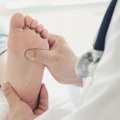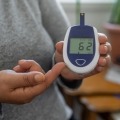New International Recommendations on Monitoring for Type 1 Diabetes
By Anna Brooks
 Universal screening for type 1 diabetes may be closer than ever. Coming soon is an international guidance document developed by JDRF and other diabetes experts worldwide for people in the early stages of type 1 diabetes.
Universal screening for type 1 diabetes may be closer than ever. Coming soon is an international guidance document developed by JDRF and other diabetes experts worldwide for people in the early stages of type 1 diabetes.
From the artificial pancreas to stem cell therapy, things have come a long way in the type 1 diabetes world. Despite advances in research and treatment, recommendations around screening – like who and how to screen – are still a little murky.
That said, many are pushing for universal screening for type 1 diabetes. Italy, for example, introduced a nationwide type 1 screening program in 2023 for children and adolescents ages 1-17. Screening is crucial because it can help delay the progression of type 1 diabetes and reduce the risk of life-threatening complications like diabetic ketoacidosis (DKA).
“As screening grows, both in the clinical and research context, so will the needs of clinicians. They’ll need to support their patients in the early stages of presymptomatic type 1 diabetes,” said Anastasia Albanese-O'Neill, assistant vice president of community screening and clinical trial education at JDRF.
“In simple terms, in clinic, we need to know what to do.”
That’s why JDRF, a leading nonprofit dedicated to diabetes research, launched a new initiative: developing global consensus guidance on monitoring for presymptomatic type 1 diabetes. With input from more than 60 experts from countries around the world, this upcoming guidance document is meant to help healthcare providers monitor and support people in the early stages of type 1 diabetes.
Why is this important?
There are three stages of type 1 diabetes. Stage 1 is when testing shows two or more islet autoantibodies (think of these as biological “warning signs” that indicate possible damage to insulin-producing beta cells in the pancreas). Stage 2 is when abnormal glucose levels start to appear along with autoantibodies. Stage 3 is when most people are diagnosed with type 1 diabetes and is marked by a significant loss of insulin production from beta cells.
Previously, it was thought that stage 3 was just the start of the disease. However, diabetes is a progressive condition, meaning it starts long before any signs or symptoms appear. The benefit of screening is early detection of type 1 in its presymptomatic phases, which may reduce the risk of complications (like DKA) and potentially delay the progression to stage 3 with medications like Tzield (teplizumab).
The problem is, said Dr. Moshe Phillip, director of the Institute for Endocrinology and Diabetes National Center at Schneider Children's Medical Center of Israel, that patients who test positive for stage 1 or 2 diabetes often don’t know what to do, nor do their doctors.
When people progress to stage 3, they’re referred to a diabetologist or endocrinologist. But in the presymptomatic stages, even if early testing is done, healthcare providers often don’t have specialized training in type 1 diabetes, which is why guidance in the presymptomatic stages is so critical.
“I’ve had many calls from physicians asking me what stage 2 is. It was not in the textbooks and we didn’t learn it in medical school,” Phillip said. “Why do we need the guidance document? Because we have to give answers to ourselves, physicians, and eventually to the people we’re taking care of.”
Monitoring is another important aspect of the new consensus statement. Monitoring is important for pinpointing where exactly a person is in the progression of type 1, as well as preventing complications like DKA.
“At my center, around 30% of newly diagnosed people come in with DKA. During COVID-19, it was close to 60%,” he said. “If you know in advance you have positive autoantibodies, your physician can tell you what to do in order to prevent DKA.”
Early detection and monitoring also leaves time to plan and prepare for the eventual need for insulin therapy, added Phillip. These are just a few of many reasons why general guidance for healthcare providers in non-specialized settings caring for people in the early stages of type 1 is so important.
What do the recommendations include?
While the guidance document is still in draft form (draft 14, to be exact), here are some of the overall goals and recommendations it includes:
-
Who should be monitored, which endpoints to monitor, as well as the frequency and duration of monitoring for people with presymptomatic diabetes
-
How to provide psychological and educational support for affected individuals and families
-
Expanding the breadth of diabetes knowledge for primary care providers, endocrinologists who didn’t study the stages of type 1, certified diabetes care and education specialists, and mental health professionals
-
Fostering partnerships between endocrinologists, primary care providers, and the type 1 community
-
Medical monitoring, including regular blood sugar assessments and patient education on the symptoms of DKA and stage 3 diabetes
-
Encouraging health providers to offer information about relevant clinical trials and available treatments to patients with stage 2 diabetes
While meant to help clinicians, especially those without formal training in diabetes, it also emphasizes practical recommendations and treatments for adults, pregnant women, and children with type 1 diabetes.
A launch date is yet to be determined, but with endorsement from partner organizations, the global guidance document is expected to be published soon.
Learn more about screening and treatment of type 1 diabetes here:








